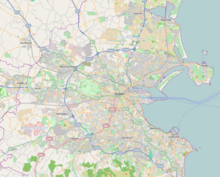Ailesbury Road
This article needs additional citations for verification. (August 2013) |
 | |
 | |
| Native name | Bóthar Aelsbaire (Irish) |
|---|---|
| Namesake | George Brudenell-Bruce, 2nd Marquess of Ailesbury |
| Length | 1.3 km (0.8 mi) |
| Width | 16 metres (52 ft) |
| Postal code | D04 |
| Coordinates | 53°19′12″N 6°13′17″W / 53.320024°N 6.221490°WCoordinates: 53°19′12″N 6°13′17″W / 53.320024°N 6.221490°W |
| west end | Arthur Morrison monument |
| east end | Sydney Parade Avenue |
| Other | |
| Known for | embassies, St Michael's College |
Ailesbury Road (Bóthar Aelsbaire in Irish), Dublin 4, Ireland, is an affluent tree-lined avenue linking Sydney Parade Station on Sydney Parade Avenue and the Church of the Sacred Heart, Donnybrook. Many embassies and diplomatic residences have historically been located on the road, including the striking residence of the French Ambassador, the embassy of the People's Republic of China, and the Japanese embassy (before it relocated to the nearby Merrion Centre.)
From Ailesbury Road, Shrewsbury Road forms the link to the Merrion Road, though Ailesbury Road meets Merrion Road near its eastern end. Other neighboring street names include Ailesbury Drive, Ailesbury Park, Ailesbury Gardens & Ailesbury Grove.
Reflecting the high property price tags in the area, Ailesbury Road is the second-most expensive property on the Irish Monopoly board, being one of the two "purple" property squares.
History[]
Danish massacre[]
In 1879 the discovery of the remains of 600 people was made at a mound on Ailesbury Road which dated back to a bloody massacre by the Danes in the 9th to 10th century. The bodies were removed and buried in the Donnybrook Cemetery.[1]
Development[]
Ailesbury road was planned in the middle of the 19th century as a residential road in south-east Dublin, within the then "Pembroke Township". It was named for George Brudenell-Bruce, 2nd Marquess of Ailesbury, who had married a daughter of the Earl of Pembroke. When first built, Ailesbury road was then the longest straight road in Dublin.[citation needed]
The original design set for houses to be built on this road is evident in numbers 1 through 51 on the south-east side of the road. These are built of red brick and granite, with a uniform flight of granite steps leading to the hall door, and iron railings bordering the front garden. Numbers 1 through 27 inclusive were built by , whose designs here and elsewhere in Dublin are characterised by circular granite pillars at the entrance gate. His own residence, which he also designed, is now St Michael’s School at the Merrion end of the road.[citation needed]
Number 53[]
The former French embassy and ambassadorial residence at number 53 is one of the most exclusive addresses on the road.[2] Formerly known as Mytilene, No. 53 differs from the "standard" building forms of numbers 1 through 51. It is much larger, detached and standing in a wooded garden, and has twin gates flanked by square granite pillars, with a granite balustrade and wide steps leading to a pillared front entrance. This house is constructed of white bricks with inset designs of black bricks and an ornamental rosette frieze, also made of bricks in the same porcelain finish.
The house was purchased by the French Government in the 1930s and became the residence of the first Minister for France to Ireland, Monsieur Alphand. This has remained so until 2008 when the French Government decided to sell off the house with price tag of €60 million making it the most expensive house ever to be put up for sale in Ireland, just after a house on Shrewsbury (just off Ailesbury Rd) that sold in 2005 for €58 million.[2]
Amenities[]
St Michael's College, a voluntary secondary school for boys with an associated primary school co-located, is situated on the road.
See also[]
References[]
- ^ Igoe, Vivien (2001). "Dublin Burial Grounds & Graveyards", Wolfhound Press, p93, ISBN 0-86327-872-8
- ^ Jump up to: a b Independent.ie - Bids to start at €60m as France says adieu to the 'Embassy Mile'
- Streets in Dublin (city)
- Diplomatic districts
- Ballsbridge
